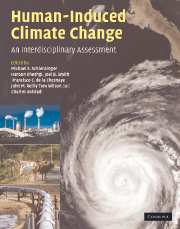Book contents
- Frontmatter
- Contents
- List of contributors
- Preface
- Part I Climate system science
- Part II Impacts and adaptation
- 9 Dynamic forecasts of the sectoral impacts of climate change
- 10 Assessing impacts and responses to global-mean sea-level rise
- 11 Developments in health models for integrated assessments
- 12 The impact of climate change on tourism and recreation
- 13 Using adaptive capacity to gain access to the decision-intensive ministries
- 14 The impacts of climate change on Africa
- Part III Mitigation of greenhouse gases
- Part IV Policy design and decisionmaking under uncertainty
- Index
- Plate section
- References
12 - The impact of climate change on tourism and recreation
from Part II - Impacts and adaptation
Published online by Cambridge University Press: 06 December 2010
- Frontmatter
- Contents
- List of contributors
- Preface
- Part I Climate system science
- Part II Impacts and adaptation
- 9 Dynamic forecasts of the sectoral impacts of climate change
- 10 Assessing impacts and responses to global-mean sea-level rise
- 11 Developments in health models for integrated assessments
- 12 The impact of climate change on tourism and recreation
- 13 Using adaptive capacity to gain access to the decision-intensive ministries
- 14 The impacts of climate change on Africa
- Part III Mitigation of greenhouse gases
- Part IV Policy design and decisionmaking under uncertainty
- Index
- Plate section
- References
Summary
Introduction
Tourism is one of the largest and fastest-growing economic sectors. Tourism is obviously related to climate, as the majority of tourists prefer spending time outdoors and travel to enjoy the sun or landscape. It is therefore surprising that the tourism literature pays little attention to climate and climatic change (e.g., Witt and Witt, 1995), perhaps because climate is deemed constant and beyond control. It is equally surprising that the literature on climate change impact pays little attention to tourism compared with the coverage of other important sectors (Smith et al., 2001), but this can perhaps be explained by the fact that most climate change impact studies are done by field experts (generic climate change impact experts are rare).
The situation is now slowly changing (e.g. Nicholls, 2004). Five branches of literature have started to grow. First, there are studies that examine the impact of climate change on tourism in a qualitative way (e.g. Viner and Agnew, 1999). Second, there are a few studies (e.g. Breiling and Charamza, 1999) that relate the fates of particular tourist destinations to climate change. Third, there are studies (e.g. Scott and McBoyle, 2001) that use indicators of the attractiveness of certain weather conditions to tourists to examine the impact of climate change. Fourth, there are a few studies (e.g. Maddison, 2001) that build statistical models of the behavior of certain groups of tourists as a function of weather and climate, and there are similar studies on recreational behavior.
- Type
- Chapter
- Information
- Human-Induced Climate ChangeAn Interdisciplinary Assessment, pp. 147 - 155Publisher: Cambridge University PressPrint publication year: 2007
References
- 5
- Cited by



